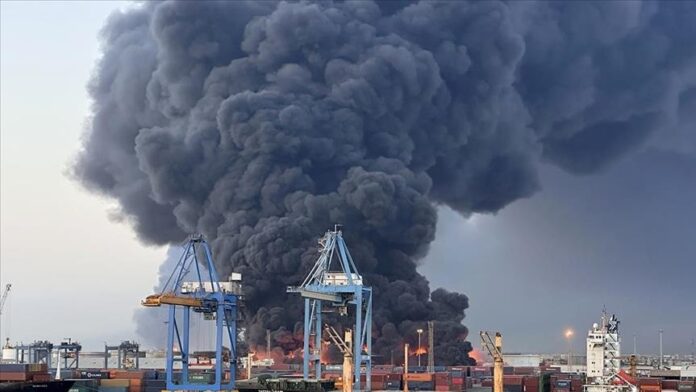A Bloody Day in Sudan: Dozens Killed and Injured as Rapid Support Forces Target Prisons and Displacement Camps
Dozens of people were killed and wounded in Sudan after the Rapid Support Forces (RSF) targeted the central prison in El-Obeid, the capital of North Kordofan State, with drones, as well as a displacement camp in El Fasher, the capital of North Darfur State.
The attacks resulted in a bloody day in Sudan, with dozens of casualties as the RSF targeted both North Kordofan and North Darfur states.
According to the Sudanese Doctors’ Network, at least 21 people were killed and 47 others injured in varying degrees after an RSF drone strike hit the central prison in El-Obeid, the capital of North Kordofan, on Saturday. The network condemned the deliberate targeting of civilian facilities, including the large prison that houses around 5,000 inmates.
In Darfur, western Sudan, fourteen members of a single family were killed in RSF shelling of the Abu Shouk displacement camp. The 6th Infantry Division in El Fasher also reported that three civilians were killed and dozens of women and children injured in RSF shelling of the city on Saturday.
In response to a week-long escalation of RSF drone attacks, the Sudanese army launched airstrikes targeting RSF warehouses and equipment in the Darfur region.
The war, ongoing for more than two years between the army and the RSF, has intensified recently, with both sides increasingly relying on long-range weaponry to strike areas under each other’s control.
Heavy artillery shelling by the RSF on Abu Shouk camp in El Fasher on Friday night killed 14 people from one family and wounded others, according to a statement from the camp’s emergency room on Saturday.
In North Kordofan, 19 inmates were killed and 45 wounded after an RSF drone strike hit El-Obeid prison, according to a medical source at the city’s hospital, who told AFP that the dead were taken to El-Obeid hospital while the wounded were being treated at El-Obeid and Al-Dhaman hospitals.
The army-aligned government condemned the prison attack as a “full-fledged war crime.” Government spokesperson Khalid Aleiser wrote on X, “We strongly condemn this terrorist act.”
Separately, the Sudanese government warned that oil exports from Sudan and South Sudan could be halted due to RSF drone attacks on oil pumping stations. The Sudanese Undersecretary of the Ministry of Energy and Oil sent a message to his South Sudanese counterpart on Saturday, informing him that a drone strike targeted the oil pumping station in Al-Hudi on Friday morning, causing severe damage and raising the likelihood of a complete halt to export operations. The message also noted that another drone targeted a fuel depot in White Nile State on Thursday, a facility used by the Sudanese Babco company.
South Sudan relies on Sudanese infrastructure to export its oil under a commercial agreement between the two countries. Sudan resumed oil exports at the beginning of this year after halting them when the war began in 2023.
Airstrikes by the Army
The RSF now relies heavily on drones and long-range weapons to attack army positions in areas that were previously considered relatively safe and are far from RSF strongholds. The government accuses the United Arab Emirates of supplying the RSF with weapons, an allegation the UAE denies.
Amnesty International recently published a report accusing the UAE of supplying the RSF with Chinese-made weapons, including “GP50A guided bombs and AH-4 shells,” based on analysis of remnants found after attacks in Khartoum and Darfur. The UAE has “strongly” rejected these accusations.
Conversely, the army is increasingly relying on its air force and fighter jets. On Saturday, the army bombed RSF positions in Nyala and El-Geneina in Darfur, destroying weapons depots and military equipment, according to a military source.
A witness in Nyala reported that “army aircraft targeted the city’s airport and locations inside the city,” adding that “the explosions were very loud.” In El-Geneina, residents heard “explosions from the direction of the airport and saw smoke rising.”
The RSF has intensified its attacks on Darfur in recent weeks, killing dozens and displacing hundreds of thousands from camps like Abu Shouk and Zamzam in El Fasher. Attacks on Zamzam camp, which housed about a million people, have forced its residents to flee, leaving it “almost empty,” according to the United Nations.
The Resistance Committees in El Fasher documented more than 750 shells-including mortars, rocket launchers, tank shells, and heavy artillery-falling on the city in the last week of April, describing it as a “bloody massacre against the city and its unarmed residents.” The committees said Saturday that shelling on El Fasher continues daily “without discrimination,” leaving residents “living between shells, not knowing what the next hour will bring.”
El Fasher holds strategic importance as the only major city in Darfur not under RSF control and is now besieged and attacked on its outskirts by the RSF. The United Nations and international observers warn of possible large-scale atrocities.
The escalation in western and central Sudan follows unprecedented RSF drone attacks in recent days on Port Sudan (east), the government’s temporary headquarters since the war began, and the new base for international organizations, diplomatic missions, and hundreds of thousands of displaced people.
These attacks have disrupted vital facilities such as the main fuel depot, the main power station, Port Sudan’s port, and its international civilian airport, which the UN calls “the lifeline for humanitarian operations.”
The war, ongoing since April 2023, has divided Sudan into areas of control between former allies: army chief Abdel Fattah al-Burhan and RSF leader Mohamed Hamdan Dagalo. The former controls central, eastern, and northern Sudan and most of the capital, while the latter holds most of Darfur (west) and parts of the south.
The conflict has killed tens of thousands of civilians, displaced 13 million people, and caused what the United Nations calls one of the worst humanitarian crises in modern history


